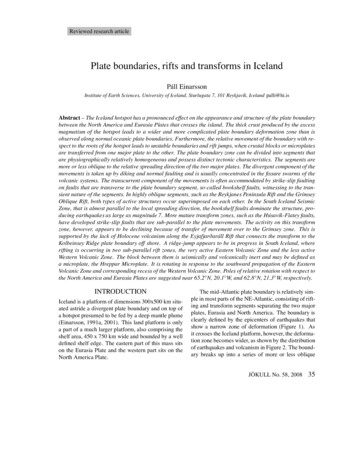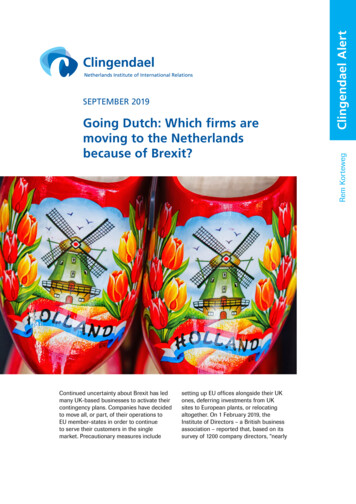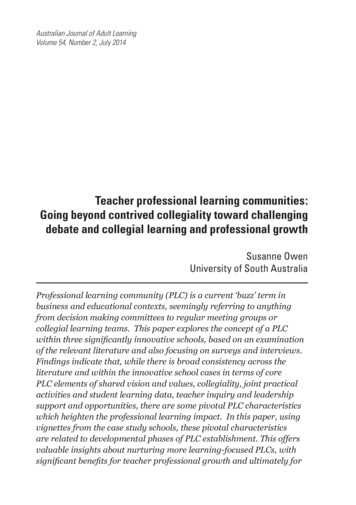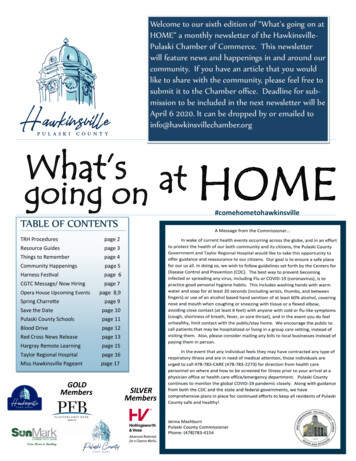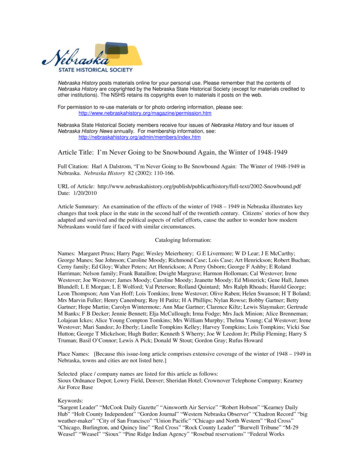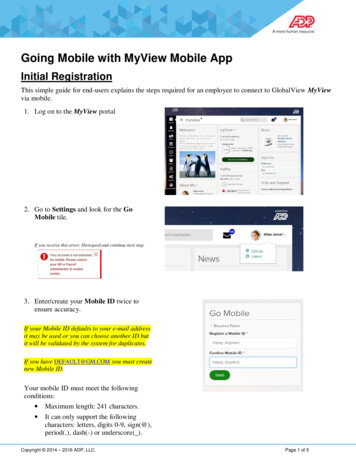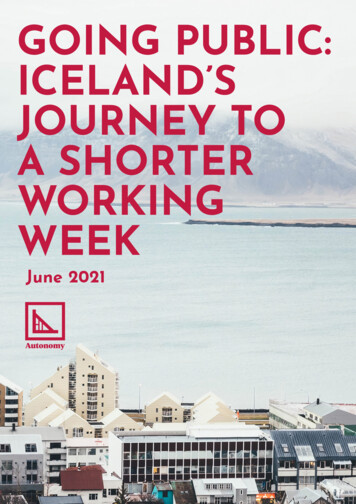
Transcription
GOING PUBLIC:ICELAND’SJOURNEY TOA SHORTERWORKINGWEEKJune 2021
AutonomyGoing Public: Iceland’s journey to a shorter working weekAuthorsGuðmundur D. HaraldssonJack KellamAlda, Association for Democracy and Sustainability, is an Icelandic organisation focusingon democracy, sustainability and other related areas, such as work. Alda is a non-profitorganisation run by volunteers and is run according to democratic principles of opennessand transparency. Alda has advocated shortening of working hours since 2011.en.alda.isAutonomy is an independent think tank that provides necessary analyses, proposals andsolutions with which to confront the changing reality of work today. Our aim is to promotereal freedom, equality and human flourishing above all.autonomy.workPublished June 2021Jointly published and presented by Alda and Autonomy Alda, Association for Democracy and Sustainability, 2021Any distribution in the unaltered original form is permittedEdited and compiled by Guðmundur D. HaraldssonProofreading by Eleanore NunnAll translations from Icelandic also by Guðmundur D. HaraldssonThe editor is solely responsible for the content presented here.Cover photo by Annie Spratt.2
AutonomyGoing Public: Iceland’s journey to a shorter working weekThis report was supported bythe Guerrilla Foundation andthe Alex Ferry Foundation3
AutonomyGoing Public: Iceland’s journey to a shorter working weekContentsExecutive summaryIntroductionThe Icelandic contextBakground to the trialsThe existing evidenceDeveloping the trialsThe Reykjavík City trial (2014–2019)The Icelandic Government trial (2017–2021)Timeline of trials and new contractsAnalysing the trialsResults and impactHow effectively was working time reduced?How were service provision and productivityaffected?Did improvements in workers’ wellbeing andwork-life balance take place?Work-life balanceEasier to do errandsParticipation in home dutiesMore time for oneselfLess stress at homePositive effects on single parentsMore exerciseWider social wellbeing4
AutonomyGoing Public: Iceland’s journey to a shorter working weekLeading by example? The experience ofmanagementConclusions from the trialsAfter the trials: continuing the path toshorter working hoursIn the public sectorIn the private sectorAppendix I: Participating workplacesAppendix II: Maintaining serviceprovisionQuantitative dataReykjavík Child Protection Services (Reykjavíktrial)Service Centers (Reykjavík trial)Department of Accountancy (Reykjavík trial)Police Westfjords (Icelandic Government trial)The Icelandic Directorate of Immigration(Icelandic Government trial)Qualitative data: information gathered usinginterviewsAppendix III: Strategies for workingtime reductionAppendix IV: ChallengesReferences5
AutonomyGoing Public: Iceland’s journey to a shorter working weekExecutive summary In 2015 and 2017, in response to campaigning bytrade unions and civil society organisations, twomajor trials of a shorter working week were initiated by Reykjavík City Council and the Icelandicnational government. These eventually involved over 2,500 workers —more than 1% of Iceland’s entire working population — many of which moved from a 40-hour to a35- or 36-hour working week. These trials not only aimed to improve work-lifebalance, but also to maintain or increase productivity. Reductions in working time were not accompanied by reductions in pay. The trials evolved to include nine-to-five workersalongside those on non-standard shift patterns,and took place in a wide range of workplaces,from offices to playschools, social service providersand hospitals. The scale of the trials, combined with the diversityof workplaces involved and the wealth of availablequantitative and qualitative data provides groundbreaking evidence for the efficacy of working timereduction. Results summarised in this report, based on bothqualitative and quantitative data, demonstratethe transformative positive effects of a shorterworking week for both employees and businessesalike. Productivity and service provision remained thesame or improved across the majority of trialworkplaces.6
AutonomyGoing Public: Iceland’s journey to a shorter working week Worker wellbeing increased across a range ofindicators, from perceived stress and burnout, tohealth and work-life balance. Following the trials’ success, Icelandic trade unionsand their confederations achieved permanent reductions in working hours for tens of thousands oftheir members across the country. In total, roughly86% of Iceland’s entire working population hasnow either moved to working shorter hours or havegained the right to shorten their working hours. These reductions were won in contracts negotiated between 2019 and 2021, and have alreadycome into effect for most workers. Some of thesecontracts give shorter hours to all union members,while other contracts stipulate that staff and theirindividual workplaces can negotiate shorter hours.7
AutonomyGoing Public: Iceland’s journey to a shorter working weekINTRODUCTION8
AutonomyGoing Public: Iceland’s journey to a shorter working week“. we have somewhat lost sight of the fact that life is not onlyabout work. Working culture here is, indeed, about workinglong hours [but] we should rethink work and adjust.”Anonymous participant.1IntroductionIn recent years, calls for shorter working hours withouta reduction in pay — often framed in terms of a ‘fourday week’ — have become increasingly prominentacross Europe. Recognition of the coming impact ofautomation and technological change on our workinglives, alongside a burgeoning desire to spend less timetied up in work has put a reduction in working hoursfirmly on the policy-making table. The ongoing Covidpandemic has only accelerated this, fuelling rapidtransitions to remote work, and unexpected increases infree time as workers have abandoned their commutesor found themselves placed on reduced working hours.It has become more and more clear that few wish toreturn to pre-pandemic working conditions: a desirefor a reduced working week is set to define ‘the newnormal’.In light of this growing interest in shorter workinghours, the ability to draw on evidence from existingtrials of a ‘four-day week’ or similar schemes willbecome increasingly important for supportive workers,organisations and politicians. This report tells the storyof two landmark trials recently conducted in Iceland:who and what drove them forward, how they weredesigned, and — most importantly — the widespreadpositive impacts that they had.1Government of Iceland (June 2019), p. 12.9
AutonomyGoing Public: Iceland’s journey to a shorter working weekFrom 2015 to 2019, two large-scale trials of shorterworking hours — in which workers moved from a 40hour to a 35- or 36-hour week, without reduced pay— commenced in Iceland, following longstanding callsfrom grassroots organisations and unions. One trial wasconducted in the capital of the country, Reykjavík, bythe city authorities and one of the major trade unionconfederations, BSRB. Starting from two workplaceswith a few dozen workers, this trial expanded to over2,500 staff in the next few years. Another trial beganbetween the Icelandic government and BSRB in 2017,comprising around 440 staff. Combined, these twotrials came to encompass more than 1% of thecountry’s working population.The trials were successful: participating workerstook on fewer hours and enjoyed greater well-being,improved work-life balance and a better cooperativespirit in the workplace — all while maintaining existingstandards of performance and productivity. The trialsalso remained revenue neutral for both the city counciland the government, providing a crucial — and so farlargely overlooked — blueprint of how future trialsmight be organised in other countries around the world.Significantly, their success impacted positively on recentrenegotiations of working contracts by Icelandic tradeunions. By the time of this report’s publication inJune 2021, 86% of Iceland’s working population arenow on contracts that have either moved them toshorter working hours, or give them the right to doso in the future. These trials are therefore an incrediblesuccess story of working time reduction, of interest tocampaigners and workers worldwide.This report summarises the results of the trials, andoffers a comprehensive account of their story anddevelopment. The aim is to provide policymakers,unions, employers and grassroots organisations with adeep insight into one of the most significant successfultrials of a shorter working week to date, adding to themounting evidence in favour of reducing working hoursworldwide.10
AutonomyGoing Public: Iceland’s journey to a shorter working weekI.BACKGROUNDTO THE TRIALS11
AutonomyGoing Public: Iceland’s journey to a shorter working weekBackground to the trialsThe Icelandic contextThe campaign for shorter working hours in Iceland hasgrown in increasing prominence over recent years. Althoughdemands for reduced working time were at first confinedto a limited number of grassroots organisations, includingnon-profits like Alda (see Haraldsson, 2013), they havesince become a focal point for a range of Icelandic tradeunions, as well as BSRB, one of the country’s largest unionfederations. Steadily, a consensus has been building withinIcelandic civil society that the country requires a reductionin working hours, with citizens starting to recognise theinjustice and inefficiency of its high levels of working time— particularly when compared to close Nordic neighbours.Iceland — much like Sweden, Norway, Denmark andFinland — provides a generous social safety net forits citizens. It boasts an advanced economy, a qualityhealthcare system, and ranks highly for income equality(OECD, 2017a). Likewise, the country has becomerenowned for offering generous paid parental leave forboth mothers and fathers (OECD, August 2019). However,in marked difference to its neighbours, Icelandic citizensare nevertheless faced with particularly long working hours.Perhaps unsurprisingly, for many years the country hastherefore lagged behind the other Nordics in evaluationsof work-life balance provided by authorities like the OECD(OECD, n.d.).Indeed, the OECD places Iceland as one of the countriesproviding the least number of hours per week for leisureand personal care — a core component of healthy worklife balance — leaving it languishing next to other workintensive states like Chile, Mexico, and Japan. Iceland isalso placed as one of the countries with the highest ratesof employees who work very long hours (OECD, n.d.). Thisofficial evidence is also borne out anecdotally: it is notuncommon to hear Icelandic people often say they feelas though they are left with little time for themselves andtheir families.12
AutonomyGoing Public: Iceland’s journey to a shorter working weekThe absence of work-life balance in Iceland is not arecent development. A 2005 study, covering a range ofadvanced economies in the Global North, found thatone in four Icelandic workers were regularly too tired todo household tasks when they arrived home from work— the highest of all surveyed countries (Stefánsson,2008). This underlines how long working hours havebecome an even more acute problem within Icelandthan they have in some other advanced economies.Interestingly, Iceland remains in a very differenteconomic situation from many of its nearby countriesin the OECD rankings on work-life balance. As can beseen in the Key Stats Box, Iceland is one of the world’swealthiest countries in terms of GDP per capita, withvery high income levels, high labour force participation,low unemployment, and an advanced service-orientedeconomy. However, it nevertheless reports lowerproductivity than many of its Nordic neighbours, aswell as higher working hours and a very long expectedworking life. On top of this, a very high proportion ofthe Icelandic population work full-time hours.The ongoing Covid-19 crisis has disrupted someaspects of this pattern — particularly through a shortterm increase in unemployment2 — but it neverthelesscaptures a deep-seated trend, likely to continueon the other side of the pandemic. The picture ofIceland’s economic problems is clear: comparativelylow productivity, long working hours and poor work-lifebalance.2The economic situation has changed after the Covid pandemic hitIceland. Unemployment is higher currently than in preceding years, andnational GDP has also fallen. However, in general, the situation has changedremarkably little: Iceland continues to have a very advanced economy andincome has remained very high (and in fact risen). Statistics from prior to theCovid pandemic are used here to portray how the country operated undermore “normal” economic circumstances.13
AutonomyGoing Public: Iceland’s journey to a shorter working weekIceland: key statsPopulation (1 January, 2019): 356,991Land area: 102,775 km2Official language: IcelandicWorking population (Q4 2019): 196,700Workforce participation (15–64 year olds): 87% — highestwithin OECDUnemployment: 3.4% — 6th lowest within OECDTotal GDP (2018): 2.8 trillion ISK / 17.6 billion GBP / 22.7billion USDGDP per person (2017): 46,981 USD — 6th highest of OECDcountries, higher than other Nordic countriesGDP per hour worked (2017): 55.4 USD — 14th of OECDcountries, lower than other Nordic countriesHours worked per week per full-time working person(2018): 44.4 — 3rd highest of Eurostat countriesFull-time workers (Q4 2019): 74.7%Duration of working life (Expected; 2017): 47 years — thelongest in EuropeWorkers by industry (% of working population, 2014):Services 77%, Industry 18.3%, Agriculture and Fishing 4.7%Note: GDP per person/hour is in 2010 PPPs.Based on: Eurostat (22 November 2019, 24 November 2019), Statistics Iceland (7February 2019), Statistics Iceland (2015, p. 95), Statistics Iceland (24 November2019a, 24 November 2019b), OECD (24 November 2019, 26 November 2019, 27November 2019).14
AutonomyGoing Public: Iceland’s journey to a shorter working weekThe existing evidenceOwing to the trends noted above, Icelandic tradeunions, civil society organisations and workers alike havein recent years increasingly argued that the country’scombination of low productivity levels and high incomes— despite Iceland’s otherwise advanced economy —should be attributed to the effects of excessively longworking hours. Worn down by long hours spent at work,the Icelandic workforce is often fatigued, which takesa toll on its productivity. In a vicious circle, this lowerproductivity ends up necessitating longer workingdays to ‘make up’ the lost output, lowering ‘per-hourproductivity’ even further.The idea that a reduction in working hours would be aneffective remedy for both Iceland’s low productivity, aswell as its poor work-life balance and wellbeing, is borneout by an array of available economic evidence.On the one hand, there is a strong correlation betweenshorter working hours and increased productivityamongst wealthy nations. Although this relation ismediated by various factors — such as levels of generaltechnological and industrial development, investment,equality, available part-time work, and so on — Figure1 shows how the link between those two factors remainsstrong: countries with greater productivity per hourusually have fewer hours of work. Furthermore, not onlydoes greater productivity usually correlate with shorterwork hours, but as productivity increases, working hourstend to go down over time.15
AutonomyGoing Public: Iceland’s journey to a shorter working weekAverage yearly working hours per worker2000190020052015Iceland18001700FinlandUnited y40506070Productivity per hour worked (PPP, USD)80Figure 1: Per hour productivity and average yearly hours across differentcountries. There is a strong correlation between shorter working hours andincreased productivity amongst wealthy nations. Source: OECD (December2017c, 2017d).Likewise, a range of studies performed in workplacesshow that where working time has been reducedand working patterns reorganised, productivity hasconcurrently increased. In their research into workingtime reduction in the last few decades of the 20thcentury, for instance, Bosch and Lehndorff (2001)note how a number of workplaces have indicatedthat successful reductions in working hours have beenclosely tied to changes in the organisation of work —whether through workers gaining greater autonomyover work processes, or changes in operating times andshift patterns. Such reorganisations have clearly had apositive impact on productivity.16
AutonomyGoing Public: Iceland’s journey to a shorter working weekThe evidence correlating reductions in working time —or simply increases in time spent away from work — withimprovements in wellbeing and work-life balance is alsostrong (see Autonomy, 2019). To offer just a sample ofthe available evidence, a comparative study of Swedishchildcare and health workers investigated the effects ofa reduction to a six-hour day, or 30-hour working week(reduced down from 39 hours) on their health and wellbeing, by comparing an experimental group to a controlgroup that remained on the same hours (Åkerstedt etal., 2001). They found that such a reduction “greatlyimproves time for family/friends and social activitiesand results in a moderate improvement of fatigue, sleepand heart/respiratory complaints” (ibid., p. 201).Likewise, in a range of studies, Sabine Sonnentagand colleagues have also looked at clerical workers,paramedics, schoolteachers, civil servants, and the selfemployed — as well as further job categories — to assessthe significance of the quantity and quality of non-worktime (Sonnentag, 2003; Fritz and Sonnentag 2005;Sonnentag et al., 2008; Sonnentag et al., 2014). Herfindings have shown that if workers are able to escapementally from their work (to ‘psychologically detach’),more readily facilitated by a reduced working week,they are often more productive, engaged on the job andconvivial with their colleagues.In conclusion, there is an established and growing bodyof evidence supporting the hypothesis that reductionsin working time can increase productivity and improveworkers’ wellbeing and work-life balance. A key to thisis the re-organisation of work and established workingpractices.17
IIDEVELOPINGTHE TRIALS
AutonomyGoing Public: Iceland’s journey to a shorter working weekDeveloping the trialsThe Reykjavík City trial (2014–2019)Campaigning by BSRB and grassroot organisationshelped to convince Reykjavík City Council membersthat changes to working time were desperately needed.In 2014, the body therefore committed to a shorterworking week trial in a selection of its workplaces, withall Council members supporting the trial (Reykjavík CityCouncil, May 25th, 2014). The project then commencedshortly after.The trial had two main aims:1. To see if working time reduction could addresspoor work-life balance, given the centrality ofthis concern to the pre-existing public campaign(BSRB, n.d.).2. To understand if shorter working hours couldincrease productivity, and see how this mightbe achieved in practice. This was particularlyimportant, since the aim was to reduce hours whilemaintaining workers’ existing salaries. As such, theworkplaces needed to maintain service provisionequivalent to that prior to initiation of the trial(Reykjavík City, 2016; June 2019).Two committees were set up to manage the scheme,develop measurements to assess its success, and createstrategies to shorten working hours (Reykjavík City,2016). Working time reductions were developed incooperation with individual workplaces to be bespoketo specific duties and modes of operation, although insome cases pre-defined strategies were applied. In manyworkplaces, discussions were held on time-managementand efficiency (Gísladóttir, 2018), and Appendix III19
AutonomyGoing Public: Iceland’s journey to a shorter working weekoffers more specific detail on how performance wasmaintained. It was also made explicit that reductions inworking time would have no impact on salaries, whichremained the same for every staff member.Initially, two workplaces were selected. The first wasa service-centre for Eastern parts of Reykjavík City,Árbær and Grafarholt, while the second was theReykjavík Child Protection Service. Both were chosenon account of the high levels of stress present in eachworkplace, which shorter working hours aimed to reduce.An additional workplace was also selected as a controlgroup for comparison. This was also an office location,albeit one that administered different duties.The trial commenced in March 2015 with these twoworkplaces shortening the hours of their workers, seeing66 members of staff participate. Hours per week wereshortened from 40 hours to 35 or 36, depending onthe particular workplace. No change was made in thecontrol group workplace (Reykjavík City, 2016).The trial grew almost thirty times in size over thenext five years, to around 2,500 participating staffin response to early positive results. Ultimately, itencompassed not only offices, but also playschools,city maintenance facilities, care-homes for people withvarious disabilities and special-needs, and beyond. TheReykjavík City Mayor’s office was included as well.The trial’s aims also expanded. First, to understandif the hours of those in irregular shift patterns couldsuccessfully be shortened. Second, to see if the longterm effects of shorter hours would be similar to theshort-term ones that had been observed (Reykjavík City,June 2019). A timeline on page 23 details how the trialevolved.In the later stages of the Reykjavík City trial, otherworkplaces could apply for participation. In theirapplication, each had to explain their strategy formaintaining a similar level of service provision onlower staff hours. Workplaces also needed to ensurethey included staff working on fixed salaries and20
AutonomyGoing Public: Iceland’s journey to a shorter working weekhad planned indicators on how to evaluate theirperformance (Reykjavík City, June 2019).The Reykjavík City trial ended on 1 September 2019,with staff reverting to their previous working hours. Afew months later, agreements were signed guaranteeingshorter hours.The Icelandic Government trial (2017–2021)In October 2015, the Icelandic Government pledgedto the trade union confederation BSRB that it wouldalso initiate a trial of shorter working hours in someof its workplaces, again moving from 40 hours to 36hour weeks, without any reductions in pay. This trialwould eventually encompass both those who workirregular shifts as well as traditional daytime workers.The aim was to understand if both workplaces andstaff would benefit from the shortening of hours, e.g. inthe form of improved work-life balance (Governmentof Iceland, 28 October 2015). In April 2016, a workinggroup was set up to steer the trial, and in late 2016 allgovernment institutions were encouraged to apply forthe trial. Similar to the trial in Reykjavík City, applyinginstitutions needed to justify how a reduction in workinghours could be achieved at the same level of serviceprovision (Government of Iceland, April 2019). Salariesalso remained the same despite the working timereduction.Again, workplaces also had to provide indicators thatthey would use to evaluate performance during the trial.To be eligible for the trial, each workplace needed tohave 20 members of staff or more, with at least 30%of the workforce being BSRB members. Roles within theapplying workplaces needed to be relatively similar, and70–100% of staff members had to work full-time hours(Government of Iceland, April 2019).The Icelandic Government trial started in April andMay 2017. Seventeen workplaces had applied, and fromthese four workplaces were selected:21
AutonomyGoing Public: Iceland’s journey to a shorter working week The Directorate of Internal Revenue (Ríkisskattstjóri). The Icelandic Directorate of Immigration (Útlendingastofnun). Registers Iceland (Þjóðskrá), A police station in Westfjords (Lögreglan á Vestfjörðum).Both the Directorate of Internal Revenue and Registersof Iceland have operations outside of Reykjavík. Thepolice station included shift workers as well as officeworkers. Four other workplaces were selected as controlgroups for the trial, so that any changes or measuredtrends could be more readily attributed to the trialrather than other external factors. The trial at thispoint encompassed around 440 staff members, with 364in control group workplaces selected for comparison(Government of Iceland, April 2019).In 2018, the Icelandic Government trial was furtherexpanded to include the Internal Medicine departmentof a hospital in Akranes in the West of Iceland. The ideawas to expand knowledge on the effects of reducedhours on a workplace where staff predominantly workedirregular hours (BSRB, n.d.).The trials at the Reykjavík City and in the IcelandicGovernment would eventually encompass more than2,500 staff members working in over 100 workplaces.This equates to around 1.3% of Iceland’s totalworkforce (Government of Iceland, April 2019; ReykjavíkCity, June 2019).The timeline below summarises the evolution of bothtrials, along with numbers of participating workers,and when results were published. A complete listingof participating workplaces can be found in AppendixI, along with information on how many hours wereshortened in each instance.22
AutonomyGoing Public: Iceland’s journey to a shorter working weekTimeline of trials and new contractsLabels: O: Offices S: School or school-related OW: Outdoor work A: Nursing or assistance for people with variousneeds SW: Shift work 4: Hours of work per week cut by four hours 5: Hours of work per week cut by five hoursSpring 2014 Reykjavík City Council agrees to start a trial ofshorter working hoursOctober 2014 Steering committee starts to prepare the trial, prepares strategiesDecember 2014 Reykjavík City Council agrees to the plansFebruary 2015 Measurements done in Reykjavík workplaces onstress and work satisfaction23
AutonomyGoing Public: Iceland’s journey to a shorter working weekMarch 2015 Service centre for Eastern Reykjavík joins trial —O,5Reykjavík Child Protection Service joins trial — O,4 66 members of staff participate in total October 2015 Follow up measurements in ReykjavíkGovernment pledges to start a trial of shorterworking hoursFebruary 2016 Follow up measurements in ReykjavíkApril 2016 Committee is set up to direct government trialMay 2016 First published results of the trial in Reykjavík(Reykjavík City, 2016). Results are positiveReykjavík City held a public meeting on the resultsJune 2016 Reykjavík City Council agrees to continue its trialand expand it24
AutonomyGoing Public: Iceland’s journey to a shorter working weekOctober and November 2016 Workplaces are added to the Reykjavík City trial Added are: Service stations for city infrastructure —OW,4Service stations for clearing and road maintenance — OW,4 Nursing and assistance in the home — A,4 A play school — S,4Around 280 staff participate in Reykjavík City trialMeasurements done in workplaces on various indicatorsApplications close for government trial after public advertisement; 17 workplaces apply, 4 are selected for trialMarch 2017 Follow up measurements in Reykjavík Measurements in government trialApril 2017 Second set of results of Reykjavík trial published(Reykjavík City, April, 2017). Again results are positive.Trial starts on government level, around 440 workers participate25
AutonomyGoing Public: Iceland’s journey to a shorter working week Directorate of Internal Revenue — O,4The Icelandic Directorate of Immigration —O,4May 2017 Further workplaces join in government trial Registers Iceland — O,4 Police in Westfjords — O,SW,4September 2017 Third set of results for trial at Reykjavík City ispublished (Reykjavík City, September 2017).October 2017 Measurements in government trialNovember 2017 Reykjavík City Council further extends trial, opening to further workplaces via applicationDecember 2017 Follow up measurements in ReykjavíkFebruary 2018 Further workplaces join trial at Reykjavík CityCouncil100 workplaces apply, around 2,500 staff participate26
AutonomyGoing Public: Iceland’s journey to a shorter working week Academic study of attitudes of CEOs and managers of large Icelandic businesses to shorter workinghours published (Viðarsdóttir, 2018).Academic study of experiences and attitudes ofmanagers at Reykjavík City towards shorter working hours published (Gísladóttir, 2018).March 2018 Workplaces join at Reykjavík City Council trial Icelandic Government trial is extended by one yearApril 2018 Workplaces join at Reykjavík City Council trial Trial at Reykjavík City includes: 7 schools 14 centres for assisted living Over 40 offices of various sizes Number of maintenance centers and teams Numerous museums, social centres, nursingteams, assistance teams, and moreFourth set of results from the Reykjavík City Council trial published (Reykjavík City Council trial,April 2018). Results continue to be positive.May 2018 Academic study on shorter working hours at Reykjavík City published (Kjartansdóttir, Kjartansdóttir & Magnúsdóttir, 2018).27
AutonomyGoing Public: Iceland’s journey to a shorter working week Academic study on the Icelandic government trial published (Helgadóttir, Sigmundsdóttir & Sölvason, 2018).Data collected from Icelandic Government trial.June 2018 Academic analysis of Iceland’s productivity, and the potential effect of shorter working hours is published (Briem, 2018), suggesting likely beneficial impact. Resultsindicate that it could be the case.Academic study on the effects of shorter working hours(Jóhannesson & Víkingsdóttir, June 2018). Results arepositive.July 2018 Workplace joins Icelandic government trial: InternalMedicine Department, Akranes Hospital SWOctober 2018 Academic study o
hour to a 35- or 36-hour week, without reduced pay — commenced in Iceland, following longstanding calls from grassroots organisations and unions. One trial was conducted in the capital of the country, Reykjavík, by the city authorities and one of the major trade
